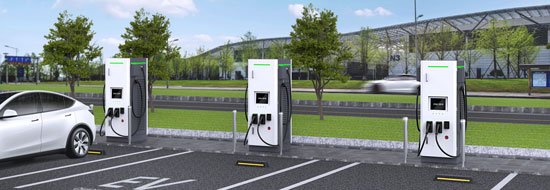How much of the electricity you’re paying for when charging your EV actually ends up in its battery? This may not be a question you ever posed to yourself, but the simple answer is “not all of it.”
Whenever you move electricity from one place to another, there are inevitable transmission losses. The further away you have to transmit it, the higher the losses, and if you’re wondering where that lost electricity goes, well, it turns into heat that dissipates. As a general rule, the higher the transmission voltage, the lower the losses.
This is why, when it is moved through the grid, the highest losses are recorded once the electricity has been stepped down from the high-voltage lines (where the voltage can be tens of thousands of volts) to the lower-voltage power lines (where it can be as low as 120 volts in the US and 240 volts in Europe). There are also losses involved with the process of stepping down the electricity via substations, as well as turning it from the alternating current (AC) of the grid into the direct current (DC) needed to charge an EV.
The easiest way for you to observe EV charging losses would be for you to completely deplete your EV’s battery, then charge it to 100 percent, and then measure how many kilowatt hours it took. You may be surprised to find out that it requires around 10 percent more electricity than your EV’s advertised battery capacity, and all of that can be attributed to charging losses.

ADAC in Germany conducted a charging test with a new BMW iX, which was hooked up to a 22 kW (16 amp) AC wall charger with an ambient temperature of 73.4°F (23°C). It found that to charge the iX’s 105.2 kWh battery pack, it actually took around 125.2 kWh. That equates to about 20 kWh (or 20 percent) losses, which seems like a lot, but it’s not far from the average loss expected when charging EVs, which is around 15 percent.
Another example of this being documented can be found in Tesla’s certification documents filed with the EPA, as quoted by Car and Driver. The data there shows that adding a little over 81 kWh to a Model Y Performance’s completely depleted battery pack via a 240-volt Level 2 charger actually required 92.2 kWh of electricity, which equates to a 14 percent loss.
Basically, the main pieces that affect charging losses when using an AC (Level 1 or Level 2) charger are the EV’s onboard AC-to-DC converter, the charger, and charging cable, the EV’s battery (and whether it has thermal management), and the charging power. Some of the electricity lost is simply attributed to what is known as “transmission losses,” some of it is lost to heat, and some is used to keep the battery temperature optimal during charging.
In another test, ADAC found that simply plugging an EV into a household socket had even bigger losses than using a wall box. When charging the Renault Zoe (which doesn’t have battery thermal management) without a wall box, it recorded losses of 24.2 percent, and this went down considerably to 9.7 percent when an 11 kW wall box was used. The difference in losses was not as great with other models that took part in the same test, but there was still a big difference in favor of using a dedicated wall-mounted charger.

Things are different when you charge your EV from a Level 3 DC fast charger, as there is no need to convert the current from AC. Data to verify how much lower losses are when DC fast-charging isn’t readily available, but they should be about 10 percent.
Our own Tom Moloughney calculated DC fast-charging losses while topping up his Tesla Model 3 a few years back from an Electrify America station and using a CHAdeMO to NACS adapter. He charged the Model 3 from a 7 percent state of charge to 57 percent, which put about 35.5 kWh back into its battery pack, and he calculated that about 3.5 kWh of that were losses. He estimated that had he charged from flat to full, total losses would have been around 7 kWh, or about 10 percent of the vehicle’s usable battery capacity at the time.
If the fast charger in question is designed to run at 800 volts and it charges an 800-volt EV, then losses should be lower, although this needs to be tested and verified before actual loss numbers are presented.
What this means to EV users around the world is that they are topping up their vehicle’s battery; they’re also paying for the electricity losses between the charger and the EV’s battery pack. You pay for the lost electricity, most of which is lost as heat, and to minimize losses, you should avoid Level 1 charging, which seems to be the least efficient.
Level 3 DC charging is the most efficient with the lowest losses, but frequently fast charging your EV can result in accelerated battery degradation, so it shouldn’t be your go-to charging solution if you want to keep an EV long-term and preserve as much of its battery capacity as possible.
[ad_2]
Source link




